A Guide to Simhachalam Temple: Details About The Abode Of Varaha Narasimha
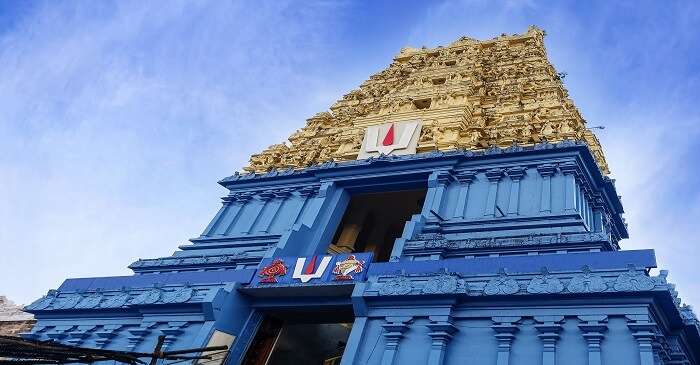
Draped on the Simhachalam hills, overlooking the vibrant city of Visakhapatnam, lies a sacred abode of Lord Vishnu – the Simhachalam Temple. Renowned for its captivating architecture and powerful deity, Varaha Narasimha, the temple attracts throngs of devotees throughout the year. The temple’s appearance from the exterior resembles a fortress with “three prakarmas” and ‘five gateways’. The blend of architecture from different rules and dynasties can be witnessed on the walls and intricate carvings. If you want to unveil more details about the Simhachalam Temple, this guide will cover it all.
History and Mythology Of Simhachalam Temple
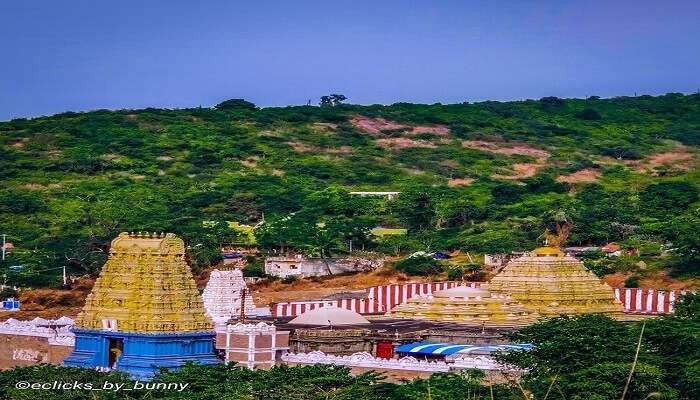
Simhachlan temple history boasts an illustrious past, dating back to the 11th century AD. Inscriptions suggest the reign of Chola king Kulothunga I was pivotal. Legends depict the visibility and emergence of the Simhachalam hill itself as a consequence of Lord Vishnu assuming the awe-inspiring form of Varaha Narasimha. For those who aren’t aware, Varaha Narasimha is the incarnation of Lord Vishnu with a lion’s head and a human’s body.
The significance behind adapting to that particular form was to vanquish the demon king Hiranyakashipu and protect his devout son Prahlada. The temple’s name ‘Simhachalam’ translates to ‘Lion Hill’, which further solidifies the temple’s association with the Varaha Narasimha form of Lord Vishnu. Over the centuries, the temple has been allocated and associated with various dynasties, including the Gajapatis, the Suryavamsis, and the Vijayanagara kings. All in all, the temple’s grandeur increased throughout each dynasty’s rule.
Must Read: Places To Visit Near Annavaram
Best Time To Visit Simhachalam Temple
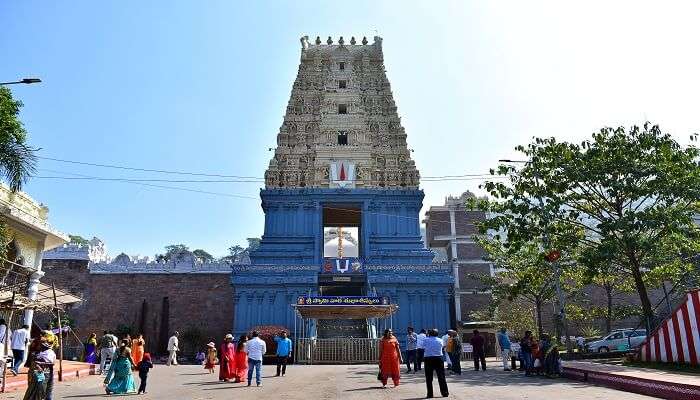
Simhachalam welcomes devotees year-round. That said, certain periods in the year are peak seasons when devotees visit from across the country and internationally. If you are particular about the weather, October to March offer the most comfortable weather. As for the peak season when pivotal festivals are celebrated in the temple, make sure to visit it during festivals, such as Kalyanotsavam (celestial wedding) in February-March, Chandanotsava (sandalwood paste festival) in May-June, and Narasimha Jayanti (birth anniversary of Lord Narasimha) in April-May.
Planning your visit during the peak season also requires you to pre-book the accommodation and transportation since thousands of devotees travel to this place during the peak season. Leaving things to the last minute might end up leading to hiked prices.
Essential Information About Simhachalam Temple

Be it Simhachalam Temple darshan timings or the ticket prices, having a comprehensive understanding of the basic information ensures an uninterrupted experience while exploring the temple and puja rituals.
Timings
The Simhachalam temple timings are from 6:30 am–2:30 pm, and 3:30 pm–7:30 pm. So, you’d have to plan your darshan experience based on these timings. Since the temple is so popular, thousands of devotees visit the temple’s premises every day. Try to reach the temple early in the morning so you can stand early in the queue and offer your prayers to the deity in an hour or two.
Entrance Fee
You don’t have to pay anything for the Simhachalam temple darshan. Some queues are managed and monitored by the temple authorities. All you have to do is stand in line and wait for your turn to offer your puja to the deity. If you want to expedite that process, a special darshan entrance ticket is available for Rs. 100 per person. They are available at the temple premises or can be purchased online as well. There is also a Suprabhata Seva, tickets for which cost Rs. 30.
Dress Code
Opt for modest clothing that covers shoulders and knees. Indian traditional attire is the ideal choice for both men and women entering the temple.
Etiquettes And rules
When inside the temple premises, prioritize decorum and maintain silence. You don’t want to create chaos in a religious place where other devotees are praying. Devotees can leave offerings of flowers, fruits, and sweets. However, avoid entering the temple with food, leather items or footwear. Personal belongings like those must be kept in the lockers outside the temple premises.
Suggested Read: Resorts In Visakhapatnam
What To Do In Simhachalam Temple?
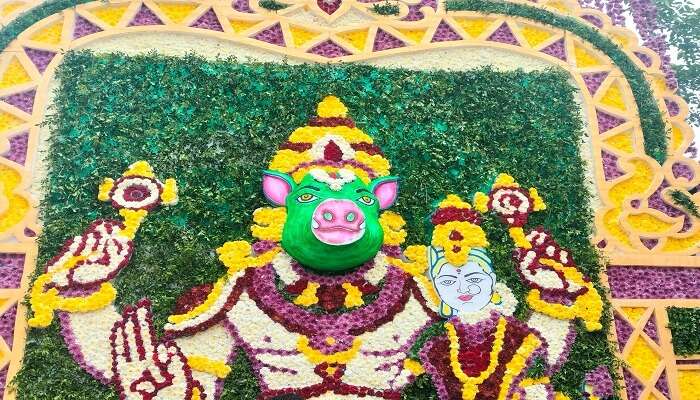
People mainly visit the Simhachalam temple to offer their prayers to Lord Varaha Narasimha. So, it’s a given that’s the first thing you will do when you step inside the temple complex. There are vendors selling flowers, sweets, and fruits outside the temple. You can purchase a small “puja thali” from them to take inside the temple. One unique trait about the temple is that the idol is covered in sandalwood paste throughout the year, except on Akshaya Tritiya. Getting to witness that in symbolic form during that day is quite extravagant.
Many kinds of ‘sevas’ are offered at the temple at different times of the day. You can visit the temple and witness those sevas as well. The inner sanctum is dedicated to Lord Varaha Narasimha while other sub-shrines represent other deities, including Lakshmi, Saraswati, and Hanuman.
Highlights Of Simhachalam Temple
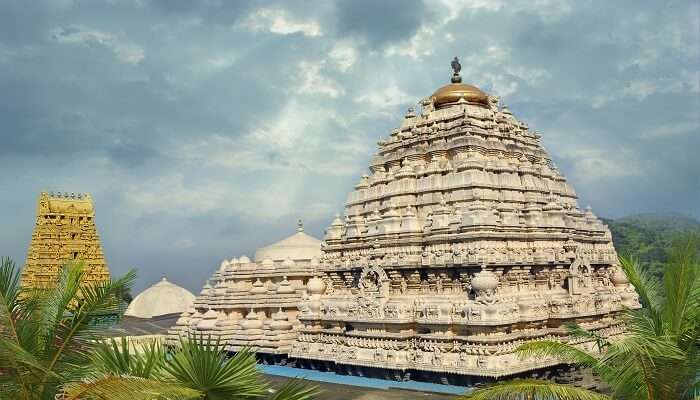
Besides the enigmatic architecture and view of the majestic Shimhachalam Temple, the biggest highlight of the temple lies in the presiding deity’s sculpture. Carved from black stone, the idol exudes power and serenity. Admire the exquisite craftsmanship of the temple’s gopurams (gateway towers), mandapams (halls), and pillars adorned with intricate sculptures depicting mythological tales. The sacred tank of Kapila Theertham believed to have medicinal properties, is also a revered spot to visit inside the temple.
As mentioned earlier, a few sub-shrines inside the temple complex are dedicated to other Hindu deities. You can visit and offer your prayers to deities and seek blessings. Once you are done offering your prayers, take some time to stroll and soak in the beauty of the temple complex.
Suggested Read: Places To Visit In Andhra Pradesh
Places To Visit Around Simhachalam Temple
What do you do once you finish exploring the Simhachalam Temple? Well, thankfully, there are quite a few amazing sightseeing spots you can consider adding to your itinerary:
1. Visakhapatnam
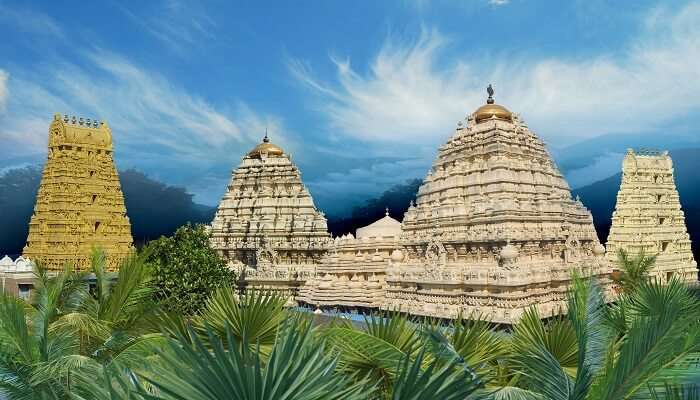
The main city of Vishakhapatnam is around 20 km away from the temple. Once you finish your darshan, explore the main region to explore the offerings in this vibrant city. Moreover, you can discover stunning beaches, viewpoints and historical attractions.
2. Borra Caves

Located 85 km from the temple, Borra Caves are a great detour if you are seeking adventure. The caves’ historical significance aside, they sport natural geological formations, which are a treat to witness in real time.
Suggested Read: Things To Do In Andhra Pradesh
3. Kailasagiri Hill Park
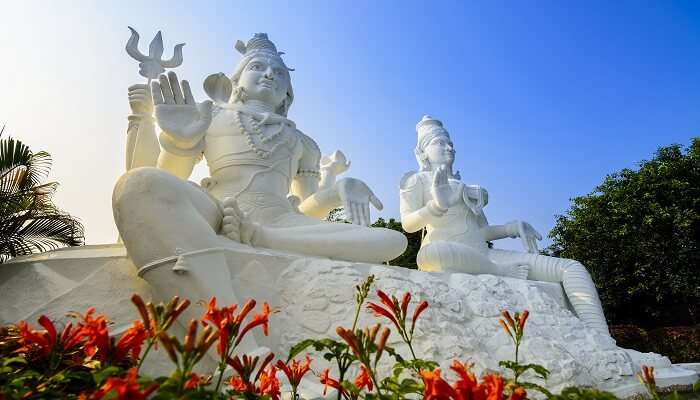
If you want to witness nature after your darshan at the temple, make your way to Kailasagiri Hill Park. The park is surrounded by lush greenery and gardens and offers panoramic views of Visakhapatnam city, which is a treat to the eyes. There are also different kinds of recreational activities available.
How To Reach Simhachalam Temple?
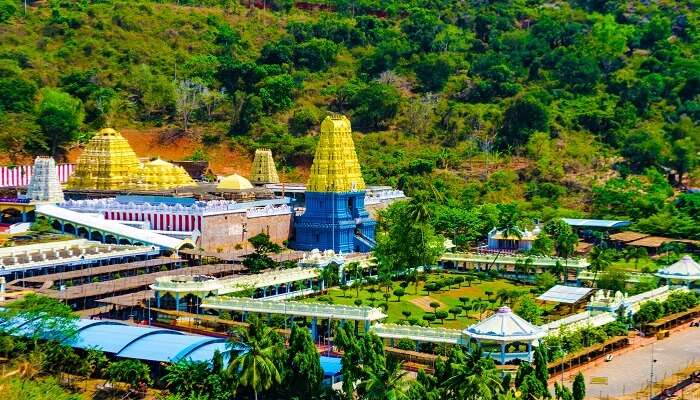
The Simhachalam Temple is conveniently located near Visakhapatnam city and is easily accessible via various modes of transportation.
By Air
If you are travelling via flight, Visakhapatnam Airport is the nearest airport to Simhachalam temple. It is around 14 km away, and many transportation options are available from the airport to the temple. You can take a cab or even opt for public transportation.
By Road
Simhachalam Temple is conveniently accessible by road. The temple is located around 18 kilometres from Visakhapatnam city centre. State buses and private taxis ply regularly on this route. If you are driving, it shouldn’t take you more than 30-40 minutes from Visakhapatnam.
By Train
The nearest railway station to the temple is Visakhapatnam Railway Station. Since it is well connected to the major cities in India, you shouldn’t face any issues reaching your destination. From the station, there are buses, autos and taxis available to take you to the temple.
Further Read: Villas In Visakhapatnam
The Simhachalam Temple is a captivating pilgrimage destination, offering a unique blend of history, spirituality, and architectural brilliance. Whether you seek blessings from the powerful Varaha Narasimha or appreciate the artistic marvel, this temple promises a fulfilling and enriching experience. Make sure you add this temple to your itinerary on your next trip to Vishakhapatnam or the areas around it.
For our editorial codes of conduct and copyright disclaimer, please click here.
Cover Image Source: Shutterstock
Frequently Asked Questions About Simhachalam Temple
What is special about the Simhachalam Temple?
Besides the grandeur and the fortress-like appearance of the temple, it also holds significance for being the abode of Lord Varaha Narasimha.
How much time is required to visit Simhachalam Temple?
The overall duration depends on your mode of transportation. On average, reaching the temple can take an hour or so from the nearest railway station or airport. Once inside the temple, you’d want to set aside 3-4 hours for the darshan.
Are there any special poojas offered at the temple?
Some sevas are offered in the temple at specific times during the day. You’d have to ask the temple authorities to get a full rundown of the sevas conducted throughout the day.
Is there any accommodation available near the temple?
There aren’t many accommodation options available near the temple. However, since Vishakhapatnam's main city isn’t far, it's ideal to book accommodation in the main city.
How much is the darshan ticket for Simhachalam?
The price for standard darshan inside the temple is free. You’d have to pay Rs. 100 per person for a special darshan.
People Also Read:
Thailand Temples Darjeeling Temples Austin Temples

Experience the world through captivating stories of adventure and travel. As a senior content writer, I bring my passion for exploration to life, crafting tales that take you on a journey. With my words, you’ll feel the thrill of discovery and the joy of experiencing new cultures. Let me turn your imagination into a reality with stories that inspire you to explore and embrace the world.











